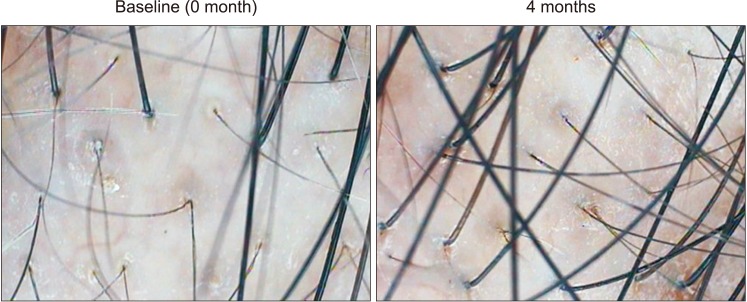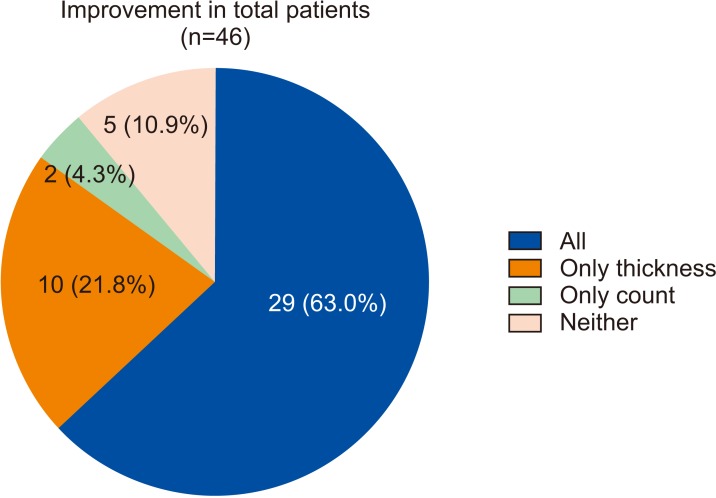1. Qi J, Garza LA. An overview of alopecias. Cold Spring Harb Perspect Med. 2014; 4:a013615. PMID:
24591533.

2. Jang SK, Kim ST, Lee DI, Park JS, Jo BR, Park JY, et al. Decoction and fermentation of selected medicinal herbs promote hair regrowth by inducing hair follicle growth in conjunction with Wnts signaling. Evid Based Complement Alternat Med. 2016; 2016:4541580. PMID:
27110266.

3. Kwon OS, Oh JK, Kim MH, Park SH, Pyo HK, Kim KH, et al. Human hair growth ex vivo is correlated with in vivo hair growth: selective categorization of hair follicles for more reliable hair follicle organ culture. Arch Dermatol Res. 2006; 297:367–371. PMID:
16328343.

4. Rile N, Liu Z, Gao L, Qi J, Zhao M, Xie Y, et al. Expression of Vimentin in hair follicle growth cycle of inner Mongolian Cashmere goats. BMC Genomics. 2018; 19:38. PMID:
29320989.

5. Choi JC, Uyama H, Lee CH, Sung MH. In vivo hair growth promotion effects of ultra-high molecular weight poly-γ-glutamic acid from Bacillus subtilis (Chungkookjang). J Microbiol Biotechnol. 2015; 25:407–412. PMID:
25502822.

6. Stefanato CM. Histopathology of alopecia: a clinicopathological approach to diagnosis. Histopathology. 2010; 56:24–38. PMID:
20055903.

7. Shapiro J. Clinical practice. Hair loss in women. N Engl J Med. 2007; 357:1620–1630. PMID:
17942874.
8. McElwee KJ, Shapiro JS. Promising therapies for treating and/or preventing androgenic alopecia. Skin Therapy Lett. 2012; 17:1–4.
9. Blumeyer A, Tosti A, Messenger A, Reygagne P, Del Marmol V, Spuls PI, et al. European Dermatology Forum (EDF). Evidence-based (S3) guideline for the treatment of androgenetic alopecia in women and in men. J Dtsch Dermatol Ges. 2011; 9 Suppl 6:S1–S57.

10. Gur S, Kadowitz PJ, Hellstrom WJ. Effects of 5-alpha reductase inhibitors on erectile function, sexual desire and ejaculation. Expert Opin Drug Saf. 2013; 12:81–90. PMID:
23173718.

11. Gordon KA, Tosti A. Alopecia: evaluation and treatment. Clin Cosmet Investig Dermatol. 2011; 4:101–106.

12. Campo D, Pisani A. Psychogenic alopecia. G Ital Dermatol Venereol. 2008; 143:283–287. PMID:
18833069.
13. Renert-Yuval Y, Guttman-Yassky E. The changing landscape of alopecia areata: the therapeutic paradigm. Adv Ther. 2017; 34:1594–1609. PMID:
28646393.

14. Delamere FM, Sladden MM, Dobbins HM, Leonardi-Bee J. Interventions for alopecia areata. Cochrane Database Syst Rev. 2008; (2):CD004413. PMID:
18425901.

15. Shapiro J. Current treatment of alopecia areata. J Investig Dermatol Symp Proc. 2013; 16:S42–S44.

16. Gümüş N, Odemiş Y, Yılmaz S, Tuncer E. Effect of topically applied minoxidil on the survival of rat dorsal skin flap. Aesthetic Plast Surg. 2012; 36:1382–1386. PMID:
22955791.

17. Gupta AK, Charrette A. Topical minoxidil: systematic review and meta-analysis of its efficacy in androgenetic alopecia. Skinmed. 2015; 13:185–189. PMID:
26380504.
18. Hagemann T, Schlütter-Böhmer B, Allam JP, Bieber T, Novak N. Positive lymphocyte transformation test in a patient with allergic contact dermatitis of the scalp after short-term use of topical minoxidil solution. Contact Dermatitis. 2005; 53:53–55. PMID:
15982234.

19. Motofei IG, Rowland DL, Georgescu SR, Tampa M, Paunica S, Constantin VD, et al. Post-finasteride adverse effects in male androgenic alopecia: a case report of vitiligo. Skin Pharmacol Physiol. 2017; 30:42–45. PMID:
28222425.

20. Poller WC, Berger A, Dreger H, Morgera S, Enke-Melzer K. Lipoprotein apheresis in patients with peripheral artery disease and lipoprotein(a)-hyperlipoproteinemia: 2-year follow-up of a prospective single center study. Atheroscler Suppl. 2017; 30:174–179. PMID:
29096834.

21. Shimizu M, Hashiguchi M, Shiga T, Tamura HO, Mochizuki M. Meta-analysis: effects of probiotic supplementation on lipid profiles in normal to mildly hypercholesterolemic individuals. PLoS One. 2015; 10:e0139795. PMID:
26473340.

22. Bouhanna P. Multifactorial classification of male and female androgenetic alopecia. Dermatol Surg. 2000; 26:555–561. PMID:
10848937.

23. Julious SA. Sample size of 12 per group rule of thumb for a pilot study. Pharm Stat. 2005; 4:287–291.

24. Mathipa MG, Thantsha MS. Probiotic engineering: towards development of robust probiotic strains with enhanced functional properties and for targeted control of enteric pathogens. Gut Pathog. 2017; 9:28. PMID:
28491143.

25. Lye HS, Kuan CY, Ewe JA, Fung WY, Liong MT. The improvement of hypertension by probiotics: effects on cholesterol, diabetes, renin, and phytoestrogens. Int J Mol Sci. 2009; 10:3755–3775. PMID:
19865517.

26. Tsai TY, Chu LH, Lee CL, Pan TM. Atherosclerosis-preventing activity of lactic acid bacteria-fermented milk-soymilk supplemented with Momordica charantia. J Agric Food Chem. 2009; 57:2065–2071. PMID:
19216552.

27. Hur KY, Lee MS. Gut microbiota and metabolic disorders. Diabetes Metab J. 2015; 39:198–203. PMID:
26124989.

28. Abularrage CJ, Sidawy AN, Aidinian G, Singh N, Weiswasser JM, Arora S. Evaluation of the microcirculation in vascular disease. J Vasc Surg. 2005; 42:574–581. PMID:
16171612.

29. Gubelin Harcha W, Barboza Martínez J, Tsai TF, Katsuoka K, Kawashima M, Tsuboi R, et al. A randomized, active- and placebo-controlled study of the efficacy and safety of different doses of dutasteride versus placebo and finasteride in the treatment of male subjects with androgenetic alopecia. J Am Acad Dermatol. 2014; 70:489–498.e3. PMID:
24411083.

30. Jeong SJ, Kwon GH, Chun J, Kim JS, Park CS, Kwon DY, et al. Cloning of fibrinolytic enzyme gene from Bacillus subtilis isolated from Cheonggukjang and its expression in protease-deficient Bacillus subtilis strains. J Microbiol Biotechnol. 2007; 17:1018–1023. PMID:
18050921.
31. Paik JH, Yoon JB, Sim WY, Kim BS, Kim NI. The prevalence and types of androgenetic alopecia in Korean men and women. Br J Dermatol. 2001; 145:95–99. PMID:
11453914.

32. Park KS, Park DH. Comparison of Saccharina japonica-Undaria pinnatifida mixture and minoxidil on hair growth promoting effect in mice. Arch Plast Surg. 2016; 43:498–505. PMID:
27896178.






 PDF
PDF ePub
ePub Citation
Citation Print
Print











 XML Download
XML Download